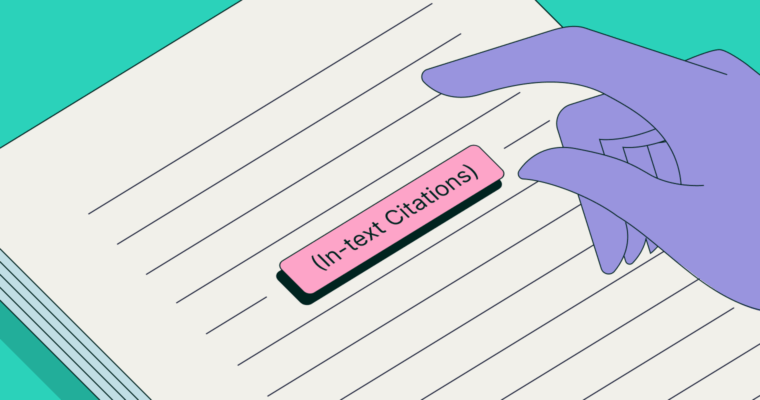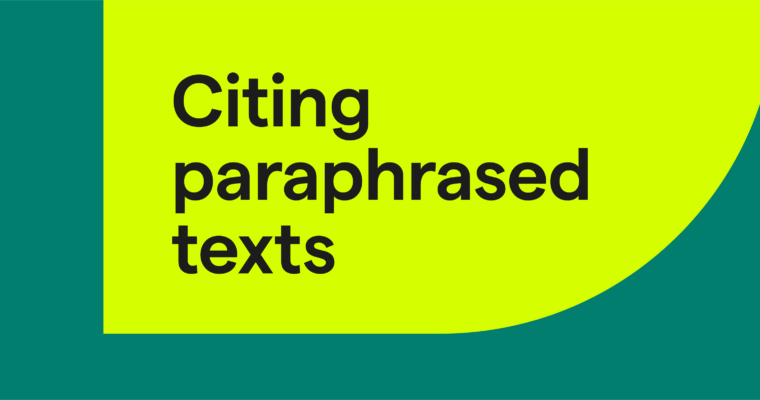
Remembering to cite your sources can be hard, but don’t forget you also have to format them according to the style guide you’re using. MLA, APA, and Chicago all have different methods for in-text citations, so you may have to change your style from paper to paper. It can be a lot to keep track of.
In this guide, we explain how to do in-text citations for MLA, APA, and Chicago, as well as discuss the difference between parenthetical and narrative citations, the two types of in-text citations. But first, let’s take a closer look at what an in-text citation is and when you need it.
What is an in-text citation?
An in-text citation is a source citation in academic writing that is placed directly in the body text, typically at the end of the related sentence, clause, or phrase. This is an alternative style to footnotes, which cite sources at the bottom of a page, or endnotes, which cite sources at the end of a section, chapter, or entire work.
In-text citations give basic source information like the author, page number, or publication year, but not details like the publisher. The complete details for a source instead go in the full citation in the bibliography at the end of the work.
Exactly which information is required for in-text citations varies whether you’re using APA, MLA, or Chicago style. However, if you’re confused about how to write your in-text citations, you can use Grammarly auto-citations or enter your source in our free citation generator to create citations for you.
Parenthetical vs. narrative citations
There are two types of in-text citations: parenthetical citations and narrative citations.
Parenthetical citations contain only enough information to identify the source, such as the author’s name, placed within parentheses (like this). Interested readers can then find the full citations in the bibliography if they’re interested in tracking down the source.
The character describes his own sacrifices as “a far, far better thing that I do, than I have ever done” (Dickens, 1859, p. 330).
Narrative citations are when the source details are mentioned directly in the body text. However, any information not included in the text must still be included in a parenthetical citation, so narrative citations and parenthetical citations are often used together.
As Charles Dickens wrote in his 1859 novel A Tale of Two Cities, “It is a far, far better thing that I do, than I have ever done” (p. 330).
When is an in-text citation required?
Generally speaking, a source citation is required in academic writing anytime an idea is presented that is not the author’s own. You can use a single in-text citation for long blocks of text like paragraphs, as long as all the information comes from the same source and location (i.e., the same page number or page range).
In-text citations are specifically required for papers written in the APA and MLA formats. If you’re using Chicago, you have a choice between in-text citations, footnotes, or endnotes, although the author still must use one of those to cite their sources.
How to do in-text citations: APA format
An APA in-text citation is written in the author-date style, which includes up to two authors’ last names and the year of publication. If the citation refers to a specific passage, like a direct quote, also include the location, such as a page number or time stamp, with the correct abbreviation (p. for page, pp. for pages, and paras. for paragraphs). Separate information with commas.
(Last Name, Year)
(Last Name, Year, p. #)
Example of an in-text citation: APA format
… or to put it another way, “unless we recognize our cognitive limitations, we will be enslaved by them” (Aronson, 1972, p. 161).
… or as Elliot Aronson wrote, “unless we recognize our cognitive limitations, we will be enslaved by them” (1972, p. 161).
How to do in-text citations: MLA format
While an APA in-text citation uses the year of publication, an MLA in-text citation requires only the author’s last name as well as a page number (if available). No commas are needed to separate the information, nor are abbreviations required for words like page.
(Last Name)
(Last Name #)
Example of an in-text citation: MLA format
. . . To summarize, “in every philosophy there is a point where the philosopher’s ‘conviction’ steps onto the stage” (Nietzsche 9).
. . . As Nietzsche summarized, “in every philosophy there is a point where the philosopher’s ‘conviction’ steps onto the stage” (9).
How to do in-text citations: Chicago format
Remember that in the Chicago format, in-text citations are optional—unlike in APA and MLA, where they are required. If you choose to use in-text citations instead of footnotes or endnotes, Chicago in-text citations follow an author-date system with the year of publication, just like citations in APA do. Also, like APA, Chicago in-text citations only use page numbers for direct quotes.
However, Chicago’s author-date format follows a couple of different rules. First, no abbreviations are needed for words like pages. Second, commas are used only to separate the year from page numbers but not to separate the author from the year.
Note that for personal communications, like an in-person interview or citing AI in Chicago, you also include the day and month of the conversation.
(Last Name Year)
(Last Name Year, #)
Example of an in-text citation: Chicago format
. . . Paranoia was common with the Turkish emirs, because “rare indeed was the emir who died in bed” (Maalouf 1984, 22).
. . . Paranoia was common with the Turkish emirs, because as Maalouf puts it, “rare indeed was the emir who died in bed” (1984, 22).
In-text citation FAQs
What is an in-text citation?
An in-text citation is a source citation in academic writing that is placed directly in the body text, typically at the end of the related sentence, clause, or phrase. This is an alternative style to footnotes or endnotes.
When is an in-text citation required?
In-text citations are required when writing papers in either the APA or MLA formats, although they are optional for the Chicago format. Generally for all formats, a citation is required every time you present an idea that is not your own in a formal piece of writing.
How does a parenthetical citation differ from a narrative citation?
Parenthetical citations place the source’s information within parentheses, while narrative citations credit the source directly in the body text as part of the narrative. Any information not mentioned in the narrative citation, such as a page number or year of publication, must still be written in a parenthetical citation.





